
There’s something about an estuary. I can’t quite put my finger on it.
Maybe it’s the simplicity. Open expanses of mudflats, silted islets between meandering water channels, clear salt air and receding horizons. An estuary sits in the here and now. It is a very mindful place to be.
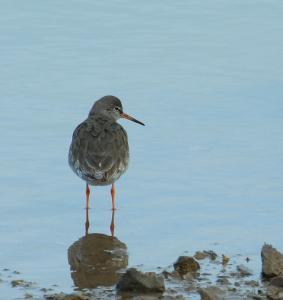
Contemplating Redshank, Ryan’s Field, Hayle Estuary (photo: Amanda Scott)
That’s certainly what I and my friend Anne found last weekend when we headed off, on a cloudy but dry day, to visit Hayle Estuary, Britain’s most south-westerly estuary. We went to practice taking photography, but we also found real companiable pleasure in sitting quietly in the hide, taking photographs, yes, but also peering through binoculars and using our own eyes to watch the birds go about their business. It was all very tranquil.
Hayle Estuary is an urban reserve: lift your eyes from the sand and mudflats and you find the buildings, homes and industry of Hayle. It makes the estuary no less tranquil, confirming how important these oases of nature are in our busy lives.
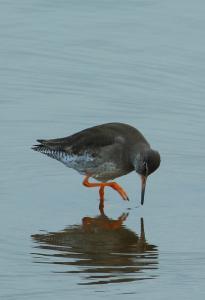
Redshank, Ryan’s Field, Hayle Estuary (photo: Amanda Scott)
We found ourselves in the Eric Grace Memorial Hide looking out over Ryan’s Field, part of the RSPB Hayle Estuary nature reserve, and were entertained for some time by Redshanks, Curlews, Black-headed Gulls, Lapwings, a Cormorant and a pair of Shelduck. As novice birders, I’m sure there was plenty else we missed. We were very fortunate, however, to be joined for a while by a real birder, who was happy to chat and confirm what we were seeing, as well as telling us a bit about the estuary and its birds. Thank you, Mr. Birder!
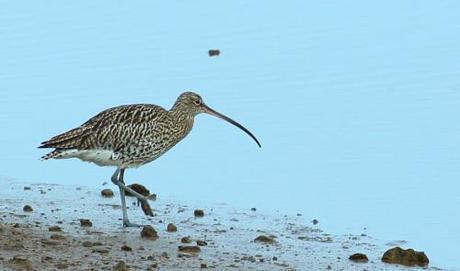
Curlew, Ryan’s Field, Hayle Estuary (photo: Amanda Scott)
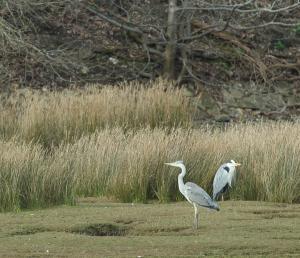
Grey Herons, Lelant Saltings, Hayle Estuary (photo: Amanda Scott)
After Ryan’s Field, we headed a bit further westwards round the estuary towards Lelant, and had a welcome cup of coffee in Birdies Bistro (Griggs Quay, Hayle, TR27 6JG) which we found quite by chance. It hasn’t been there long, apparently, and is a place to be recommended, not just for the cheerful atmosphere, but also for the way the back garden is set up with viewing ‘slits’ in its fence, just like a hide, looking out over Lelant Saltings. We spotted some Grey Herons doing their standing completely still act, as well as a load of gulls doing their standing still with heads tucked under wings act.
After that, we headed off to Porth Kidney Sands, which sit at the mouth of the Hayle Estuary, somewhere that Anne has been to before with her family, whereas it was my first visit. There is limited parking, but you can park just before St Uny Church and then take the footpath down towards the beach (instructions at the end of this post).
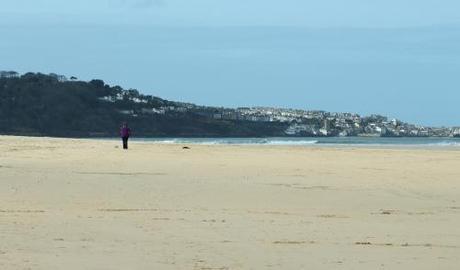
Porth Kidney Sands, looking west, with St Ives in the distance (photo: Amanda Scott)
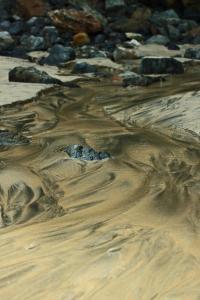
This streamlet made some beautiful patterns in the sand as it ran across the beach (photo: Amanda Scott)
At low tide the beach here is vast, with an expanse of sand stretching to the sea in front of you, and dunes ranging inland behind you. We didn’t spot much in the way of bird life on the beach or out to sea but, in the distance at the sea’s edge, there were surfers enjoying the waves and dogs bounding about happily in the water. Even so, as we turned west to walk along the sands a little way, staying close to the dunes, the depth of the beach still gave an air of seclusion and separation. After a few minutes walk along the beach, there is a clear track, doubling back in terms of direction but making its way along the top of the dunes: this is a section of the South West Coast Path. Follow this and cross the railway over a footbridge, and eventually you rejoin the path that took you down to the beach.
On the way, we saw a female Stonechat, perching on bramble and surveying her world…
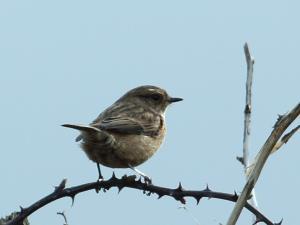
Female Stonechat, in the dunes behind Porth Kidney Sands (photo: Amanda Scott)
…and in the churchyard cemetery we found snowdrops – a welcome sign of spring!
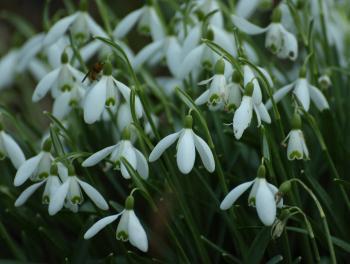
Snowdrops, Lelant (photo: Amanda Scott)
This was a lovely, peaceful way to spend a few hours – the gray skies if anything suited the tranquillity and mood, though I never say no to sunshine!
See below for how to get to the places we visited.
Hayle Estuary RSPB reserve, including Ryan’s Field: link here to directions on the RSPB site.
Birdies Bistro: link here to their Facebook page. The Bistro is on the right on the A3074, just to the south of Lelant.
Porth Kidney Sands: This link to the Cornwall Beach Guide gives good directions about where to park.


